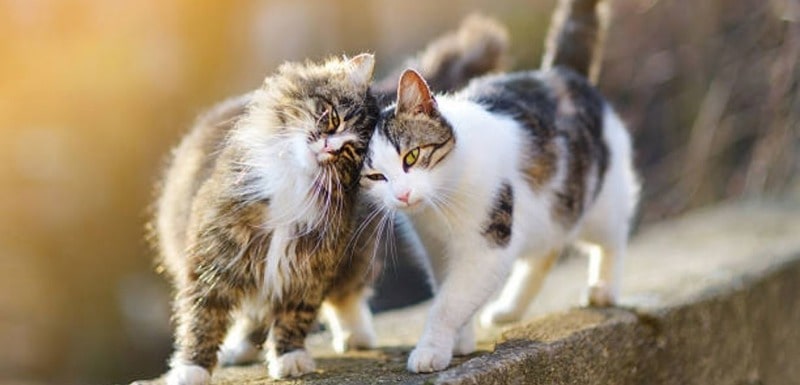
When cats are young, they stay with their mother until they mature and reach sexual maturity. Males will leave to find a mate while females might stay with their mothers or form a matriarchal society in larger colonies.
Do Feral Cat Siblings Stay Together?
Based on the hypothesis that siblings that grow up together are more likely to stay together, an experiment was done by researchers. They found that feral cat siblings stay together 53% of the time.
Do Feral Cat Families Stay Together
Some experts say that feral cats are so busy looking for food and trying to stay safe that they have no time or inclination to stick together. Others maintain that they do, but they only form temporary groups because it’s difficult to find more than one spot with enough food and cover.
Some studies believe that the answer lies somewhere in the middle of these two extremes, where a feral cat’s family unit is not always permanent and may even change from day to day.
Do Cat Siblings Stay Together In The Wild?
Well, we would have to say that the answer is an emphatic “no!” In fact, a new study found that more than 50% of wild cats never see their siblings again after they become adults.
Do Feral Kittens Stay Together
The bond between feral cats generally depends on their personality, but for those who do become friends with each other, it’s unlikely that they would ever be separated.
Do Cats Stay As Couples?
Most experts believe that whether or not the cats stayed together depended on their gender and how close they were in proximity to one another.
Do Stray Cats Have Packs?
When cats are in groups, this does not mean that they are members of a pack like dogs. Some people believe that felines exist in hierarchal societies where certain cats occupy the top position and this is why they stay in packs.
How Many Cats Make A Colony
Colony size depends on the species and on individual factors such as age, sex, and reproductive status. Larger colonies are found on average in more northern areas, in cats of unneutered females, among female cats with kittens less than two months old, and among those which have given birth during the previous six months.
Why Do Cats Form Colonies?
Cats naturally hunt small prey in groups. They have a tendency to congregate near the place where they feed and will sometimes stay near it for a long time afterward. This can lead to feral cat colonies forming in areas that are rich with wildlife and without humans.
How To Get Rid Of A Feral Cat Colony
When a feral cat colony is identified, there are a few steps to be taken in order to get rid of them. First, the animal needs to be trapped and euthanized. Next, all shelter sources need to be removed from the area and any food source within an inch of the ground needs to be covered with wire mesh or metal sheeting or buried 6-12 inches below ground. This will force the remaining feral cats to leave the area because they will lack both food and shelter.
Do Male Cats Live In Colonies?
In the wild, male cats do live in colonies for the sake of mating. But in a home, male cats typically only live together when they are young and have yet to reach adulthood.
Do House Cats Form Prides?
There is no scientific evidence to support this claim. In the wild, the pride of lions consists of related females and their offspring as a coalition against other pride. House cats do not have any alliance with each other which means they cannot form a pride like the lions in Africa.
Do Cats Have A Pack Leader?
Cats do not have a den leader, but they do have some sort of hierarchy predominately with the female cats being more dominant than the male cats. Cats do not have a pack leader because they are solitary animals.
How Do Feral Cat Colonies Start?
There are many factors that can lead to the formation of a feral cat colony.
- One factor is when someone begins caring for a single or small group of cats. This type of caretaker typically does not have enough time or resources to take care of the cats properly and will eventually abandon them.
- The second factor is humans who intentionally start colonies, either by releasing their pet cats into the wild or by deliberately breeding them.
- The third factor is when people dump unwanted pet cats on a piece of land where they will become feral and reproduce rapidly as a result of being fed by passersby on nearby roads.
Are Cat Colonies Good?
Here’re some possible pros and cons.
Possible pros:
- The cats are outside, so they don’t disturb anyone who doesn’t want them around.
- They usually keep mice populations down.
- They’re less likely to show aggression towards humans if the person isn’t trying to feed them or intervene in their lives in any way.
Possible cons:
- Some colonies may bully other animals such as birds and squirrels out of food sources and nesting sites.
- Cats may show aggressive behaviors towards people if they feel threatened. For example, if someone tries to pet or feed them!
Do Wild Cats Live In Packs?
In the wild, cats often live in colonies. These colonies are usually headed by one male cat and one or more females who mate with him and give birth to his kittens.
How Long Do Feral Cats Stay With Their Kittens?
The mother will stay with her kittens for about two weeks after they are born, and she will feed them every four hours around the clock. She mostly stays within 25 feet of the nest in which they were born while they grow to around 8-11 pounds in weight.
